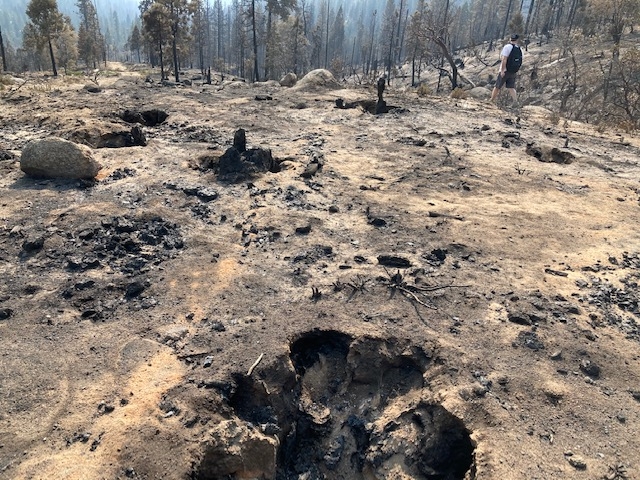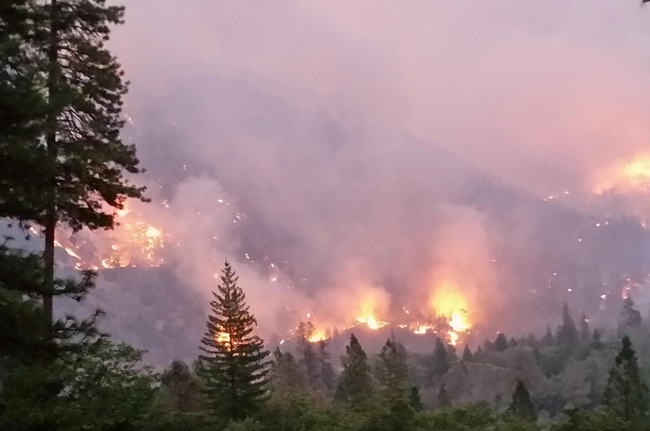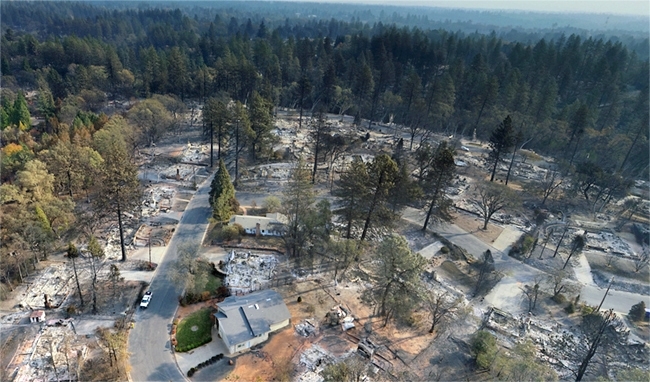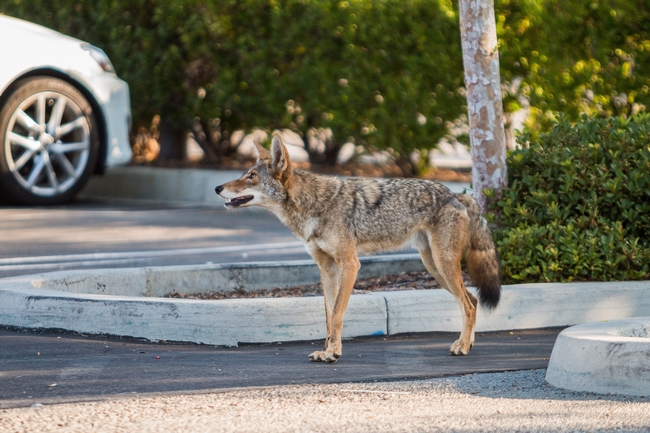
Posts Tagged: environment
Wildfires are devastating to the soil
After another record year for California wildfire, concern is now turning to the soil impacted by firestorms, reported Sarah Klearman in the Napa Valley Register.
High-temperature flames can incinerate vegetation and destroy plant root systems, said Toby O'Geen, UC Cooperative Extension soil specialist at UC Davis. The loss of vegetation destabilizes the landscape, making it vulnerable to serious erosion or flooding.
"The most important way to battle erosion is to have surface cover - living vegetation anchoring your soil," O'Geen said. "We have none of that. If you have soil with existing susceptibility (to erosion) and now nothing to hold it in place, it's a new disaster."
Particularly catastrophic fire can make the soil surface water repellent, which allows water to pond up and release higher concentrations of run-off water even when rainfall is low.
"That creates more massive erosive events - it gives rise to accelerated erosion, and in some extreme instances, mudslides," O'Geen said.
Climate change is converting cities into 21st century ghost towns
In California, most ghost towns were created when a local industry collapsed. Now, climate change is more often to blame when booming communities whither and die, reported Daniel Cusick in E&E News.
In an eerie horror story released just before Halloween, Cusick wrote about five towns around the nation that have died or are dying from climate-related disasters. Historic Shasta and Helena, Calif., are featured in one of the vignettes.
"Those are two towns that are getting more ghostly," said Yana Valochovich, UC Cooperative Extension forestry advisor in Humboldt and Del Norte counties.
A 19th-century mining town, Shasta City had been a preserved tourist destination in Shasta State Historic Park since 1937 when it was burned in the 2018 Carr Fire, the seventh most destructive wildfire in California history. Helena, a 170-year-old pioneer mining settlement, burned in the Helena Fire of 2017.
There almost certainly will be more "dead towns" as fires consume more of Northern California, Valochovic added.
North Coast forests are more dense and dry, fueling fires
Five of California's six largest fires have occurred in 2020, reported Julie Cart in CalMatters.
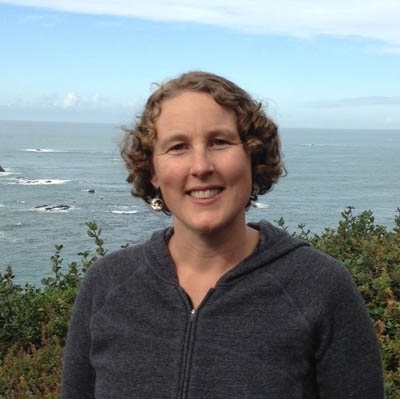
Quinn-Davidson is based in Humboldt County, with typically rainy, foggy redwood forests. However, she said, the forests don't resemble their former state.
"They are suffering from the same things that the rest of the state forests are. They are poorly managed and have fuels buildup," Quinn-Davidson said.
Redwood and pine forests are many times more dense than at any time in their history.
"We are now entering a new regime, the climate is changing and we are seeing drier conditions and we are seeing a longer fire season. We are not getting that fall precipitation," she said.
The state's 2018 Fourth Climate Assessment included dire predictions for the North Coast: “Future wildfire projections suggest a longer fire season, an increase in wildfire frequency, and an expansion of the area susceptible to fire.”
Average annual maximum temperatures in Mendocino, Humboldt, Del Norte, Lake, Trinity and Siskiyou Counties could increase by as much as 9 degrees through the end of the century, the report concluded.

The fog that reliably blankets the North Coast is dissipating. Research from UC Berkeley found that fog frequency has declined by a third compared with a century ago.
“Even here in Humboldt County — we are right on the ocean, basically in a rainforest — people are starting to look around and say, ‘Is my house ready for a wildfire?' I'm hearing those conversations,” Quinn-Davidson said.
Protecting homes from wildfire in a time of climate change
Many climate change projections point to impacts that will be felt 50 or 100 years from now. But there are indications the earth is already experiencing rising sea levels, intensifying storms, increasing wildfires and droughts, and warmer oceans and atmosphere, reported Mary Caperton Morton in Science News.
For information about wildfire in California, Morton spoke to Max Moritz, UC Cooperative Extension wildfire specialist in the Bren School of Environmental Science and Management at UC Santa Barbara.
“Warming temperatures are melting snow sooner and drying out vegetation so that we're already seeing longer fire seasons and more available fuel," Moritz said.
In 2017 and 2018, California wildfires killed 147 people, burned 3.5 million acres and destroyed over 34,000 structures in two of the worst fire seasons on record. Wildfires are expected to become more severe across the West.
Governor Newsom is responding to the threat by including in his proposed 2020-2021 state budget $86 million for CALFIRE to boost its firefighting response and $127 million for the Department of Emergency Services to address such disasters, reported the San Francisco Chronicle. The proposed budget will also fund the creation of a new 106-person wildfire safety division to oversee Pacific Gas & Electric Co. and other utilities.
CALFIRE recommends establishing defensible space around homes and building to code with fire-safe materials. For older homes, CALFIRE suggests low-cost retrofitting strategies, including sealing gaps with caulk, weather stripping or fine metal mesh screens; removing dead or dry vegetation from around the house and regularly cleaning leaves and other flammable material from gutters and under decks.
Moritz pointed out that the houses themselves are fuel for wildfire. Community-level fire safety approaches will be needed, he said.
"You've probably seen aftermath photos where a fire has swept through a town and all the homes have burned, but there are still trees standing and green vegetation,” Moritz said. “That's what happens when the homes themselves are the fuel. It's not a land management problem where you should have cleared more shrubland. You can't thin the fuels because the homes were the fuel.”
In a report published in April by UC Agriculture and Natural Resources, Moritz and colleagues also recommend burying power lines, creating water storage facilities for fighting fires, hardening emergency facilities and creating community refuges where people can take shelter.
"A whole suite of risk-reduction measures can be applied at the community scale,” he said. “We need to pay attention to how we lay out communities, with buffer zones between houses and between the community and the surrounding landscape.”
“Building to Coexist with Fire: Risk Reduction Measures for New Development” can be downloaded free at https://anrcatalog.ucanr.edu/Details.aspx?itemNo=8680.
Are coyotes becoming bolder in California while humans shelter in place?
Coyote sightings are on the rise in San Francisco, even taking naps in patches of green spaces in the city, reported Uma Chrobak in Popular Science. However, it is unlikely they indicate a change in wildlife behavior, said UC Cooperative Extension human-wildlife interactions advisor Niamh Quinn.
Officials believe the increased sightings may have more to do with a change in human behavior. Many people are at home and bored, so they may staring out the window and going on more walks in their neighborhoods.
Quinn follows five radio-collared coyotes in Los Angeles for a research project. She says her coyotes haven't changed their routines since the shelter-in-place order went into effect, staying in their respective territories, which include areas near a shopping mall and golf course.
The number of coyotes reported in San Francisco on Quinn's Coyote Cacher website isn't unusual, she said.
“People are just at home noticing more things,” she said, "especially in California, we're not all spending five hours a day on the freeway [now], you know?”
If you see coyotes or other wildlife, give them space, Quinn said. “It's very important to keep wildlife wild,” she said. “You should never feed wildlife.”
Coyote sightings can be recorded on the Coyote Cacher website, and the public can view a map of coyotes sightings by ZIP Code on the site.
